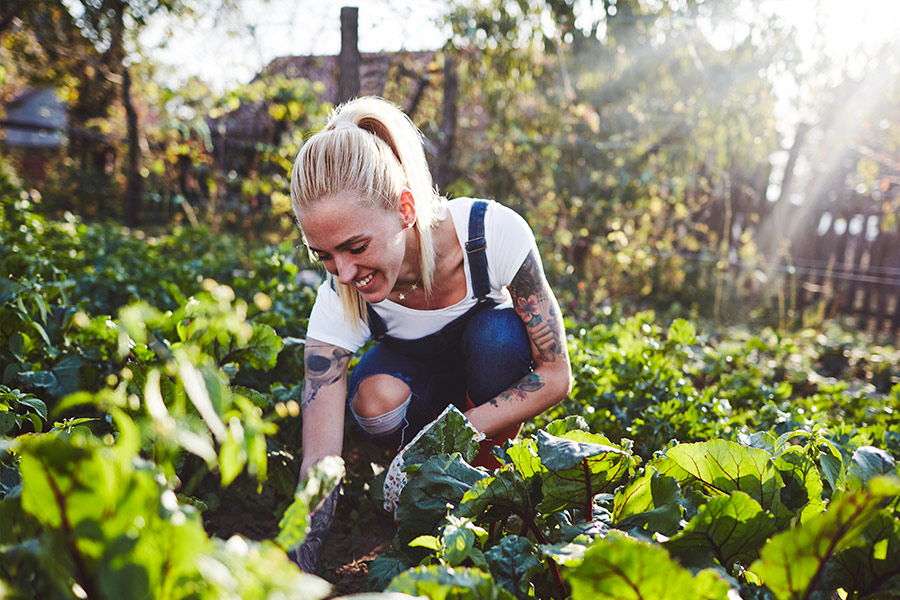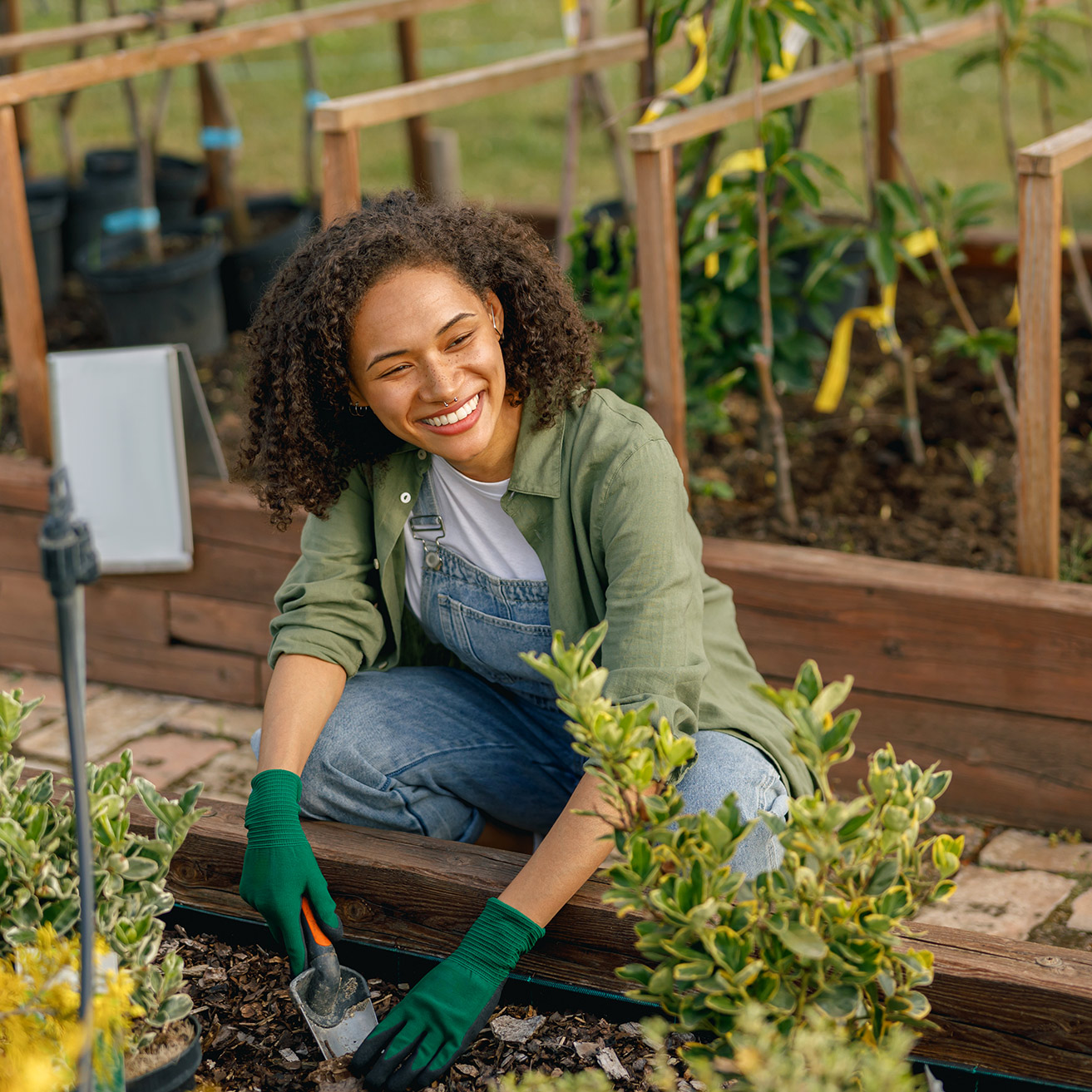Money Saving 301
Five Budget Small Garden Ideas

If you’re thinking about starting a small garden this year but aren’t sure you can afford it, don’t worry – there are tons of amazing DIY garden ideas out there. From sharing seeds to cuttings to smaller plants, you can experiment and save – and if you’re successful, you can even lower your grocery bills. Check out these five ideas for budget small garden ideas.
How to Start a Garden on a Budget

Growing a garden on a healthy budget shouldn’t be too intimidating. After finding a space with good sunlight and good soil, you can think about your plants. There are lots of ways to get plants:
- Start seeds. If you plan ahead, you can buy seeds and start them indoors. While you can buy seed starting kits with trays and special soil inserts, it’s not necessary. You can also start plants in used yogurt cups (washed of course), egg cartons, or even doubled-up Dixie cups. Anything small like these will allow the plants to get started. You can place the cups on a cookie sheet or other tray and put them somewhere they’ll get sunlight. How much light they need varies by plant, so check the back of the seed packets for more information. Using a small bag of seed starting or garden soil will give your plants the best chance of success.
- Look for sales. Early in the season, garden centers will start to offer seedlings and packs of plants that are already started. Very often, you’ll find sales on these items. Shopping around and comparing prices can save you a lot in the long run, especially if you’re planting a complete garden. Also, consider plant size- early in the season, you may be able to buy a larger number of small plants for the same money as a large one. As long as you have time for them to grow, there’s nothing wrong with smaller plants! As the season progresses, you may want to look at larger plants so they are farther along in the journey to maturity (and making the vegetables or fruits you’re waiting for).
- Find a plant or seed swap. Various organizations in your area probably offer plant sales or seed swaps of some kind. If your area has a gardening program for those with mental health or other physical concerns, these programs often sell plants to raise money. Educational gardening programs often do the same; 4-H could be a great resource, too. Farmer’s markets could include plants in the early season. And gardening organizations of all kinds can help you find resources for plants. Most areas also have a local extension office which can help. Just do an internet search for “local extension office” with your county name to learn more.
Save with Off-Season Shopping
It’s important to know the growing season for your area, which can also help you save money. Every area in the U.S. is labeled as part of a zone according to its climate. Knowing your zone number will help you choose plants that will be successful in your area so you don’t waste your money.
Your growing period begins after the last frost in the spring and ends when frost returns in the fall. Knowing this can help you find good plants that have arrived too early or late at the garden center.
There are a lot of sales in the early or late planting seasons. Take advantage of them! If it isn’t planting time yet in your area, you can keep the plants inside until you’re past the risk of frost. As you get late into the planting season – think July or August – you can also find plants on sale. As long as you give your plant a good start by making sure it’s healthy before transferring it outside, you should be successful. If it’s very hot, just consider planting on a cloudy or rainy day if possible to ease any transplant shock. One tip: with vegetable plants, find out the time to maturity before you consider planting them late in the season. If it will frost in a month but it takes the plant 60 days to produce fruit, there’s not much point unless you plan to bring the plant indoors at the end of the season.
Grow Your Garden
To make more plants at no cost, consider trying plant propagation. This is where you cut off a small part of a plant (known as a “cutting”) and put it in soil or water until it produces roots. Then it can be transferred into a small pot, and when it’s strong enough, you can plant it outside. You can easily find lists of which plants will propagate and what they need online. Most herbs will propagate easily, including mint, sage, thyme, basil, and more. If you know a friend with a plant you want, ask if you can take a cutting. Wrap it in a wet paper towel and it should travel a short way home.
You can get lots of other free plants from friends. Sometimes neighbors will dig up plants to change their landscaping, and you can offer to take them. Many perennials must be divided every few years, which is a great opportunity to share and swap plants with friends.
If you run into any problems growing your small garden, like pests, your local greenhouse or county extension office should be able to help you understand what’s needed. If you do have a diseased plant in a pot, be sure to wash the pot with a weak bleach solution before using the next year again. Look online for specific instructions.
Making the most of your space will also allow you to grow more plants. Think creatively – green beans will follow a trellis or virtually any structure of wire or string, like an old hammock. Tomatoes can be grown in pots or even upside down in special tomato bags. If you can grow plants upward, that leaves you more space just above the soil for other lower-growing plants. Many traditionally unruly vegetables are now also available in shrub or bush form, like zucchini. These varieties may be a good choice for a small DIY backyard garden.
Garden with Kitchen Scraps
You can even keep costs down with your plant care.
Starting a composting bin is a great option if you want to garden. Many communities will provide a free one and/or a free class to help you get started with composting. You can also find plans online to build one yourself from salvaged wooden pallets or other materials. Using fruit peels from oranges, bananas, apples and mangoes can help keep pests like mosquitoes away while adding nutrients to the soil. Think about it – you’re using your trash instead of just throwing it in the landfill, and you get better yield and quality from your garden. If you’ve got the space, that’s a win.
Selecting plants that continue growing after harvest, like potatoes, mushrooms, green onion, garlic and herbs is also a great way to keep costs down. You can take one potato from the bunch, for example, and that plant will keep producing and growing more for harvest. These types of plants are a great investment.
Learn More and Join a Gardening Community or Club
Learning more about gardening from an expert is also a great way to keep costs down. Most gardeners will tell you there are plenty of ways to use items from around the house in your garden. Taking courses with a local organization can help you learn more and more of these tricks of the trade. Books and courses from the library are also an incredible resource. PBS television offers lots of shows about gardening and different kinds of plants, and cooking shows can help you learn what to do with a wide variety of vegetables.
As part of a club or organization, not only could you meet people to swap plants or seeds with, you may have an opportunity to buy in bulk so you get good plants at a lower cost. These organizations exist everywhere, both in person and online.
So do a little research and give a garden a go! You don’t have to spend a lot to learn a lot and grow.
Editorial Policy: The information contained in Check `n Go’s Finance Academy Learning Center is for educational purposes only and is not legal advice. You should consult your own attorney or seek specific advice from a legal professional regarding any legal issues. Check `n Go does not act as a credit counseling, repair service, or debt consolidation service in providing this content. Please understand that Check `n Go policies change over time. Blog posts reflect Check `n Go policy at the time of writing. While maintained for your information, archived posts may not reflect current Check `n Go policy.
The information contained in our blog posts are the author’s own opinions, not those of Check `n Go or any other company. Any pros and cons are developed by our editorial team based on independent research. Some of the products, services, and offers on this page may not be available from Check `n Go. In Texas only: Check `n Go does not act as a credit services organization in providing this content.



